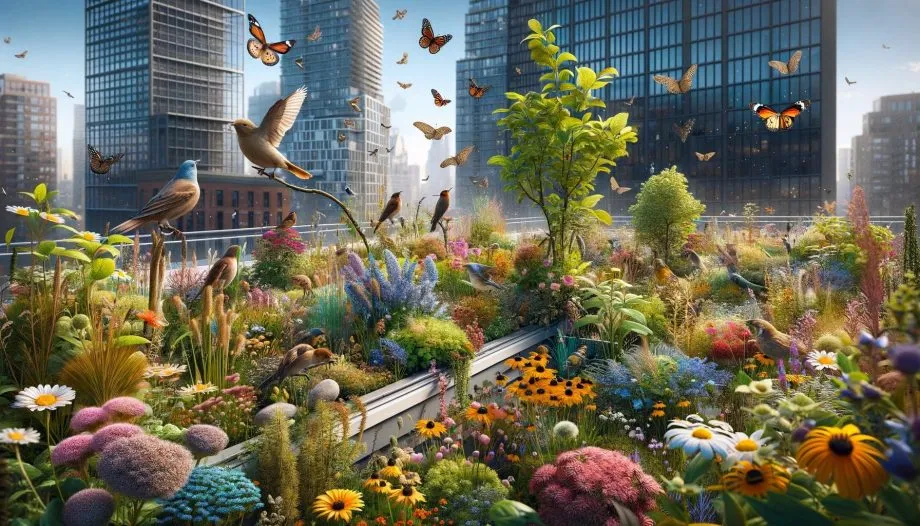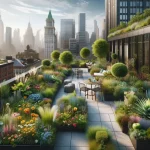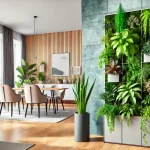This post may contain affiliate links. If you buy something from one of our links we may earn a commission. Thanks
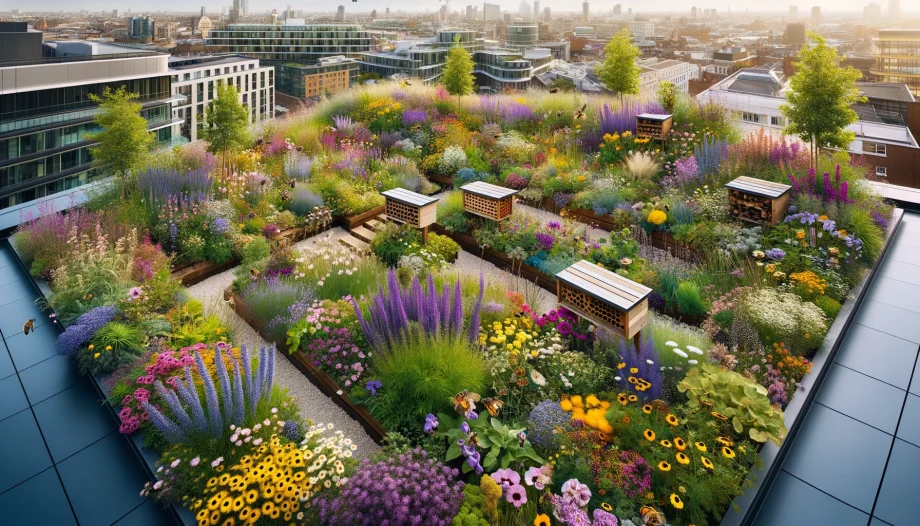
Explore pollinator-friendly rooftop gardens! Discover how they boost biodiversity, beautify urban areas, and provide a sustainable solution for cities.
Pollinator-Friendly Rooftop Gardens
Key Takeaways:
Welcome to the world of pollinator-friendly rooftop gardens! These urban oases are not only a feast for the eyes but also a vital lifeline for pollinators.
Join us as we explore how these green spaces can transform rooftops into vibrant habitats, supporting biodiversity and adding a touch of nature to the concrete jungle.
Pollinator-Friendly Rooftop Gardens
Pollinator-friendly rooftop gardens are not only a beautiful addition to urban landscapes but also play a crucial role in supporting biodiversity and pollinator populations.
We will explore the importance of these gardens, how to create and maintain them, and the numerous benefits they bring.
From reducing the urban heat island effect to increasing property value, pollinator-friendly rooftop gardens are a sustainable and rewarding investment.
Join us as we delve into this growing trend and discover some inspiring examples of successful rooftop gardens.
What Are Pollinator-Friendly Rooftop Gardens?
Pollinator-friendly rooftop gardens are green spaces created on rooftops that are specifically designed to attract pollinators such as bees by offering a habitat filled with diverse plants and flowers.
These gardens play a crucial role in supporting the declining bee population, which is essential for pollination and maintaining biodiversity.
As urbanization continues to expand, these rooftop havens serve as vital refuges for native bees and other pollinators, helping them thrive amidst concrete jungles.
Why Are Pollinator-Friendly Rooftop Gardens Important?
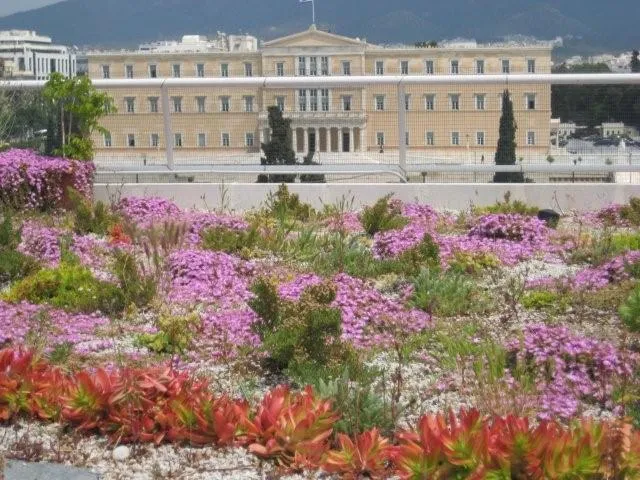
Pollinator-friendly rooftop gardens play a crucial role in urban environments as they provide essential habitats for native bees and other pollinators, promoting biodiversity and supporting sustainable practices.
These green spaces not only beautify urban landscapes but also help combat the decline of pollinator populations by offering food sources and nesting sites.
By creating a network of interconnected habitats, rooftop gardens facilitate pollinator movement, enhancing plant reproduction and urban biodiversity.
Plant diversity is encouraged, leading to healthier ecosystems and improved resilience against environmental challenges.
These gardens contribute to sustainable urban practices by reducing energy consumption, mitigating the urban heat island effect, and purifying the air.
Promotes Biodiversity
One key benefit of pollinator-friendly rooftop gardens is their ability to promote biodiversity by creating diverse habitats that support native bees and other pollinators, contributing to the overall urban biodiversity.
By providing a variety of nectar-rich flowers, rooftop gardens cater to the specific needs of different pollinator species, ensuring a sustainable food source throughout the seasons.
The presence of green roofs in urban settings not only improves air quality but also offers a refuge for pollinators in a habitat-scarce environment, further boosting their populations.
Native bee species, well-adapted to local flora, thrive in these green spaces, playing a crucial role in the pollination of urban plants and crops.
Supports Pollinator Populations
Pollinator-friendly rooftop gardens are essential for supporting pollinator populations in urban environments, ensuring the provision of ecosystem services through the cultivation of native plants and pollinator-friendly habitats.
These rooftop gardens serve as crucial oases within the concrete jungles of cities, offering refuge and sustenance to bees, butterflies, and other essential pollinators.
By creating havens filled with native plants that these pollinators rely on for food and shelter, urban dwellers can contribute significantly to conserving biodiversity and ensuring food security.
The presence of such green spaces helps combat the negative impacts of urbanization, such as habitat loss and fragmentation, by providing interconnected corridors for pollinators to thrive.
Reduces Urban Heat Island Effect
By integrating green spaces like pollinator-friendly rooftop gardens, cities can effectively reduce the urban heat island effect, mitigate stormwater issues, and enhance urban development with thoughtful plant selection and sustainable practices.
The implementation of pollinator-friendly rooftop gardens can significantly impact a city’s microclimate by providing a cooling effect through vegetation and shade, thereby lowering overall temperatures in urban areas.
These green spaces act as natural sponges, absorbing and filtering rainwater to help manage stormwater runoff and reduce the strain on drainage systems.
Including native plant species in these rooftop gardens fosters biodiversity and encourages the presence of essential pollinators like bees and butterflies, thus promoting a healthier urban ecosystem.
In the realm of sustainable urban planning, such initiatives play a crucial role in enhancing green infrastructure, reducing the carbon footprint, and fostering community engagement in urban greening projects.
How To Create A Pollinator-Friendly Rooftop Garden?
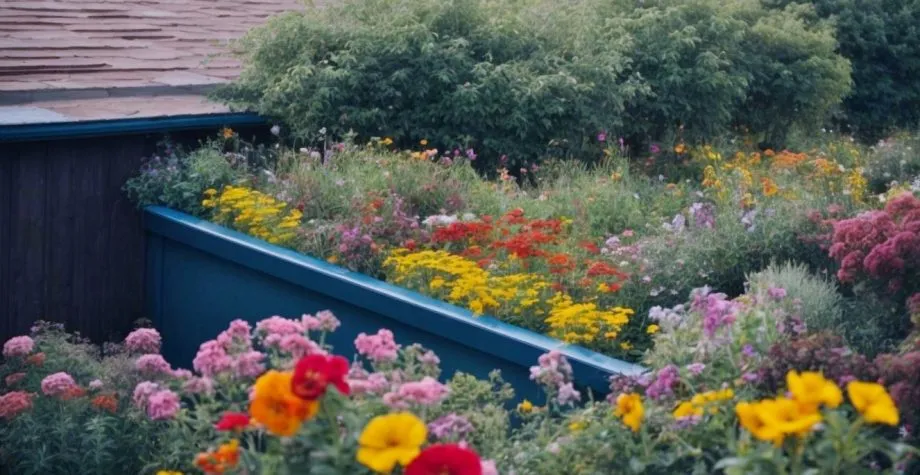
Creating a pollinator-friendly rooftop garden involves careful selection of plants that attract bees, integrating green roof elements, and designing a habitat that supports urban ecology and native bee populations.
One of the key aspects to consider when selecting plants for a pollinator-friendly rooftop garden is to choose a variety of flowering species that provide nectar and pollen for bees.
Sedum, with its hardy nature and vibrant blooms, is a popular choice due to its ability to thrive in rooftop conditions.
Incorporating a mix of native wildflowers and perennial herbs can also enrich the garden’s biodiversity and attract a diverse range of pollinators.
Choose the Right Plants
Selecting the right plants is crucial for creating a pollinator-friendly rooftop garden that supports urban gardening practices, provides pollinator protection, and attracts a diverse range of pollinators.
When choosing plants for your rooftop garden, opt for native species that are well-adapted to the local climate and soil conditions.
These plants not only require less maintenance but also offer a natural food source for pollinators.
Including a variety of flowering plants that bloom at different times of the year ensures a continuous food supply for bees, butterflies, and other pollinators.
It’s also essential to avoid using pesticides or chemicals that can harm these beneficial insects.
By following these guidelines, rooftop gardens can serve as vital oases for pollinators in urban settings.
Provide Shelter and Water Sources
To create an ideal pollinator-friendly rooftop garden, it is essential to provide shelter options and water sources that cater to bee habitats, offer nesting opportunities, and contribute to the overall ecosystem health.
Shelter is crucial for pollinators as it provides protection from harsh weather conditions and predators.
By incorporating bee houses, plant coverings, or artificial shelters, rooftop gardens can attract and retain a diverse range of pollinators.
Similarly, water sources play a vital role in sustaining pollinator populations. Whether through small ponds, birdbaths, or strategically placed containers, providing accessible water helps maintain hydration levels crucial for the well-being of bees and other pollinators.
Consider the Structure and Layout
When designing a pollinator-friendly rooftop garden, careful consideration of the structure and layout is essential to create a suitable habitat for pollinators, integrating sedum species, and ensuring a pollinator-friendly design.
Structural elements such as raised beds, trellises, and water features can provide nesting sites and resting areas for pollinators, enhancing the overall biodiversity of the garden.
Incorporating sedum species not only adds visual interest but also serves as a valuable food source and shelter for bees, butterflies, and other pollinators.
By following urban gardening principles like maximizing vertical space and using recycled materials, rooftop gardens can play a crucial role in supporting pollinator populations in urban environments.
What Are the Benefits of Having a Pollinator-Friendly Rooftop Garden?
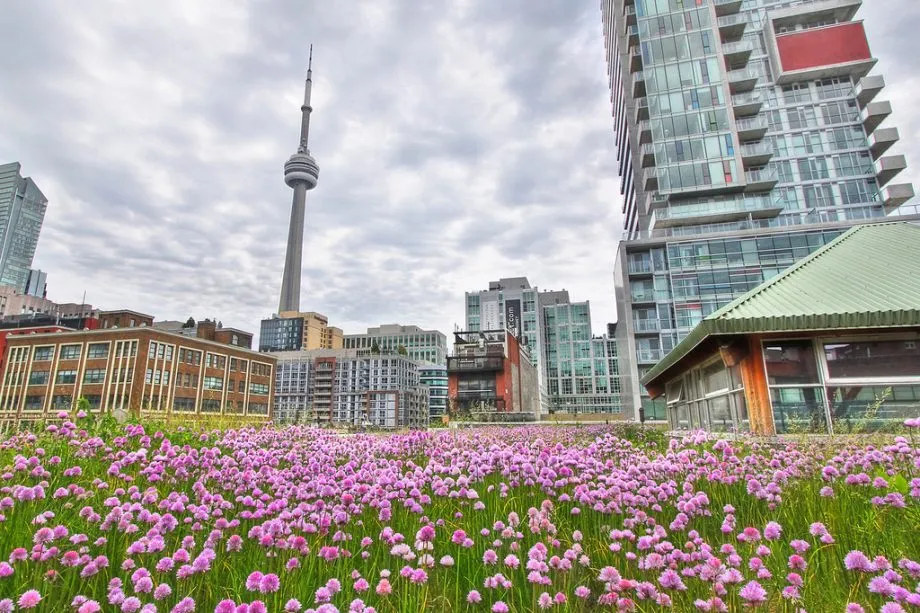
Having a pollinator-friendly rooftop garden offers numerous benefits, including creating a beautiful and functional space, improving air quality, reducing energy costs, and increasing property value.
- Aesthetically, a rooftop garden enhances the urban landscape, providing a green oasis amidst concrete jungles.
- Functionally, it serves as a habitat for bees, butterflies, and other pollinators crucial for plant reproduction.
- The presence of vegetation helps regulate temperature, reducing the urban heat island effect and lowering energy consumption.
- Improved air quality is a significant advantage, as plants naturally filter pollutants and release oxygen.
- With a rooftop garden, homeowners can enjoy lower utility bills due to better insulation and reduced energy demands.
- Property values tend to increase with the addition of green spaces, attracting eco-conscious buyers and investors.
- The urban ecosystem benefits from increased biodiversity and green areas, contributing to a healthier environment.
- A pollinator-friendly rooftop garden becomes a sustainable and rewarding investment for both individuals and communities.
Creates a Beautiful and Functional Space
A pollinator-friendly rooftop garden creates a beautiful and functional space in the urban environment, providing a habitat for wildlife and incorporating a diverse plant palette to attract pollinators.
These gardens not only add to the aesthetic appeal of rooftops but also serve as important ecological oases in bustling cities.
By mimicking natural habitats, rooftop gardens offer refuge to bees, butterflies, and other essential pollinators, aiding in the conservation of biodiversity.
Through the use of native plant species and strategic planting designs, these gardens can attract a wide array of pollinators, contributing to the health of urban ecosystems and enhancing overall urban biodiversity.
Improves Air Quality
The presence of pollinator-friendly plants in rooftop gardens contributes to improving air quality through habitat creation, effective stormwater management, and enhanced plant diversity that benefits both pollinators and the environment.
Pollinator-friendly plants play a crucial role in attracting bees, butterflies, and other pollinators, which not only aids in plant reproduction but also enriches biodiversity.
By providing suitable habitat for these pollinators in urban spaces, rooftop gardens act as essential green corridors that support their populations.
The presence of these plants helps in reducing the urban heat island effect by providing shade and cooling effects, which in turn lowers energy consumption for indoor cooling, thereby reducing greenhouse gas emissions.
Reduces Energy Costs
Incorporating sustainable practices in pollinator-friendly rooftop gardens can help reduce energy costs associated with urban development, offering insights from research on the benefits of such green spaces.
Research has demonstrated that the integration of sustainable features, such as green roofs, can lead to significant reductions in building energy consumption.
By using natural elements like plants and soil to insulate and cool buildings, these rooftop gardens can contribute to lowering the reliance on heating and air conditioning systems.
The presence of pollinator-friendly plants in these gardens enhances biodiversity and promotes ecosystem services. This not only aids in the conservation of native flora and fauna but also improves air quality and overall well-being in urban areas.
Increases Property Value
Having a pollinator-friendly rooftop garden can increase property value in cities by incorporating features like flower boxes, community gardens, and sidewalk planters that enhance the overall urban landscape.
The presence of these green spaces not only beautifies the concrete jungle but also attracts vital pollinators like bees and butterflies, which play a crucial role in maintaining biodiversity and supporting plant reproduction.
Such amenities contribute to a sense of community and well-being, providing residents with a peaceful escape from the hustle and bustle of city life right at their doorstep.
Embracing these sustainable initiatives creates a more sustainable and eco-friendly urban environment, fostering a harmonious relationship between nature and urban development.
How To Maintain a Pollinator-Friendly Rooftop Garden?
Maintaining a pollinator-friendly rooftop garden involves regular watering and fertilizing, pruning and weeding to preserve green space, and effective pest management strategies that consider the hardscape and furnishings of the urban environment.
In terms of watering, the key is to ensure consistent moisture levels without overwatering, especially in containers or raised beds common in rooftop gardens.
Utilizing drip irrigation systems or smart watering technologies can help optimize water usage.
For fertilizing, choosing organic options can promote healthier soil and plant growth while minimizing environmental impacts.
Understanding the specific nutrient requirements of the plants in your garden is crucial to providing appropriate fertilization.
Pruning plays a vital role in maintaining the health and shape of plants in urban settings.
Regularly inspecting for dead or diseased branches and shaping plants for optimal growth can enhance the overall aesthetics of the rooftop garden.
Regular Watering and Fertilizing
To maintain optimal pollinator populations, regular watering and fertilizing of plant communities in urban areas are essential, requiring expertise from landscape architects who understand the impact of hardscapes on ecosystem health.
Proper watering ensures that plants have the necessary moisture for growth and blooming, which is crucial for attracting and supporting pollinators like bees and butterflies.
Additionally, fertilizing provides essential nutrients that enable plants to thrive and produce nectar and pollen, essential food sources for these vital pollinators.
The symbiotic relationship between plants and pollinators is integral to maintaining urban ecosystem balance.
Landscape architects play a pivotal role in designing green spaces with diverse plant varieties that cater to different pollinator species, encouraging biodiversity and enhancing the overall health of urban environments.
Pruning and Weeding
Pruning and weeding practices play a key role in preserving plant diversity and green spaces for pollinators, necessitating expertise from planting designers who focus on plant selection tailored to the urban environment.
Effective pruning and weeding not only help maintain the aesthetic appeal of green spaces but also contribute significantly to the overall health of plant ecosystems.
By carefully selecting which plants to keep and which to remove, planting designers can create environments that support a diverse range of plants, attracting a variety of pollinators such as bees, butterflies, and birds.
This careful curation is vital in urban settings where space is limited, making each plant choice crucial for the vitality and sustainability of the green areas.
Pest Management
Effective pest management strategies are vital for protecting pollinator-friendly plants and urban gardening ecosystems, minimizing habitat fragmentation, and preserving urban biodiversity in rooftop garden environments.
By employing pest management techniques that are environmentally friendly, rooftop gardens can thrive without causing harm to important pollinators like bees and butterflies.
Maintaining a balanced ecosystem within urban settings through habitat connectivity ensures the survival of beneficial insects that aid in plant pollination and overall biodiversity.
Integrated pest management practices play a crucial role in sustaining the delicate urban balance, fostering a harmonious coexistence between humans, plants, and insects in these compact green spaces.
What Are Some Examples of Successful Pollinator-Friendly Rooftop Gardens?
Several successful examples of pollinator-friendly rooftop gardens showcase innovative design approaches that excel in stormwater management, plant sourcing, and establishing urban pollinator hot spots within cities.
One standout example of a renowned pollinator-friendly rooftop garden is located in the heart of a bustling metropolis.
This garden not only serves as a lush oasis amidst concrete jungle but also acts as a prime model for sustainable urban practices.
By integrating a diverse selection of native plants, this rooftop garden attracts a myriad of pollinators, contributing to the local ecosystem’s health and biodiversity.
The design of this garden incorporates effective stormwater management features, such as strategically placed permeable surfaces and rainwater harvesting systems.
These elements not only reduce water runoff but also help in replenishing local groundwater sources, showcasing a holistic approach to sustainability.
Brooklyn Grange Farm
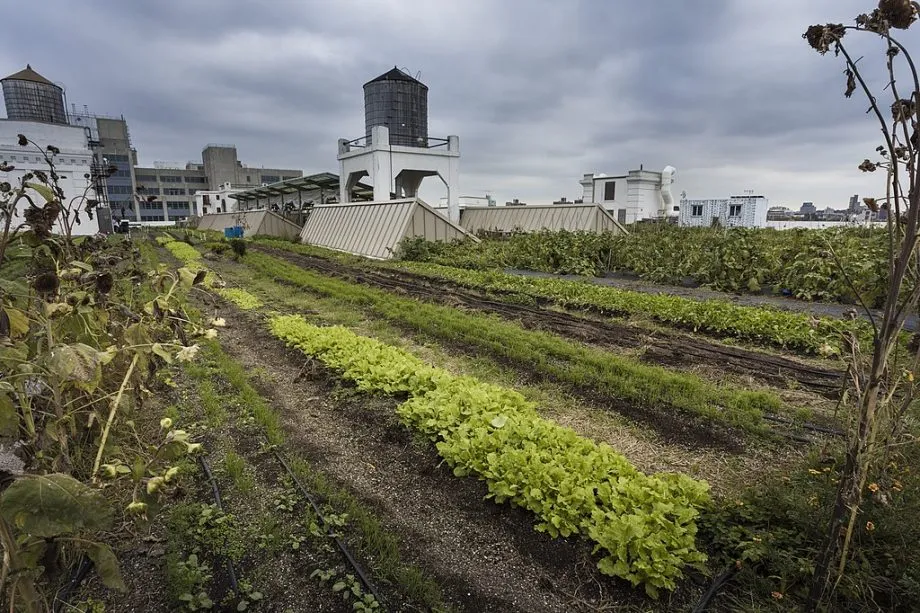
The Brooklyn Grange Farm serves as a model for supporting pollinator populations by using local plants in an urban development setting, attracting wildlife and transforming rooftops into vibrant rooftop gardens.
One of the key factors contributing to the success of Brooklyn Grange Farm is its strategic use of native plants that are well-adapted to the local climate and environment, providing essential nectar and pollen sources for bees, butterflies, and other pollinators.
This deliberate selection of plants not only enhances pollinator populations but also fosters ecosystem resilience and biodiversity in an urban landscape.
By establishing lush rooftop gardens, the farm contributes to the beautification of the cityscape, offering a green oasis amidst concrete jungles.
These green spaces not only serve as havens for pollinators but also attract diverse bird species, creating a harmonious urban ecosystem.
Chicago City Hall Rooftop Garden
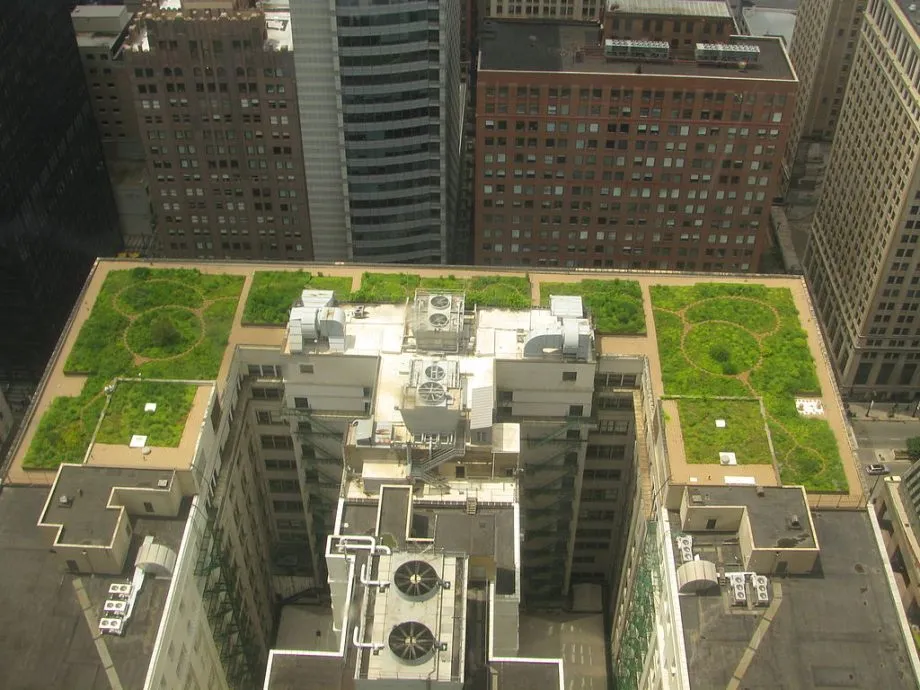
The Chicago City Hall Rooftop Garden showcases the integration of native vegetation to create diverse pollinator habitats, adapting to the city’s climate and supporting butterfly species, exemplifying the potential of rooftop gardens.
One of the remarkable aspects of this green oasis is its ability to not only survive but thrive in the hustle and bustle of the urban environment.
The garden acts as a sanctuary for various butterflies, providing them with essential nectar sources and breeding grounds.
The carefully selected native plants attract a myriad of pollinators, contributing to the overall biodiversity of the area.
Visitors can witness firsthand the synergy between the garden and the city, illustrating the harmonious coexistence between nature and metropolitan life.
Fairmont Waterfront Hotel Rooftop Bee Garden
The Fairmont Waterfront Hotel Rooftop Bee Garden stands out as an urban pollinator sanctuary attracting monarch butterflies, embodying a community garden spirit, and contributing to the creation of urban pollinator hot spots with innovative sidewalk planters.
With its breathtaking views of the city skyline, the Rooftop Bee Garden provides a tranquil oasis where these vital pollinators thrive amidst the bustling urban landscape.
The garden’s focus on sustainability and biodiversity not only supports the local ecosystem but also offers an educational opportunity for visitors to learn about the importance of pollinators.
Creating urban pollinator hot spots fosters a healthier environment and promotes a harmonious coexistence between nature and urban development.
Through its inclusive garden approach, the Fairmont Waterfront Hotel exemplifies how businesses can play a vital role in enhancing biodiversity in cities, ensuring a greener future for generations to come.
Frequently Asked Questions
Q. What are pollinator-friendly rooftop gardens?
A. Pollinator-friendly rooftop gardens are rooftop spaces that are intentionally designed and maintained to attract and support pollinators, such as bees, butterflies, and hummingbirds.
These gardens provide a habitat for pollinators in urban areas, where natural green spaces are often lacking.
Q. Why are pollinator-friendly rooftop gardens important?
A. Pollinator-friendly rooftop gardens play a crucial role in supporting the declining population of pollinators.
These gardens provide a food source and shelter for pollinators, allowing them to thrive and continue pollinating plants, which in turn supports the growth of crops and wild plants.
Q. What types of plants should I include in a pollinator-friendly rooftop garden?
A. There are a variety of plants that are attractive to pollinators and suitable for growing in rooftop gardens.
These include native wildflowers, herbs, and small shrubs. It is important to choose plants that bloom at different times of the year to provide a continuous food source for pollinators.
Q. How can I make my rooftop garden pollinator-friendly?
A. To make your rooftop garden more pollinator-friendly, start by avoiding the use of pesticides and opting for organic gardening methods.
Incorporate a variety of plants, provide a water source, and create sheltered areas for pollinators to rest.
It can also be helpful to work with a local gardening expert to learn more about native pollinators and their habitat needs.
Q. What are the benefits of having a pollinator-friendly rooftop garden?
A. Aside from supporting pollinators and contributing to their conservation, pollinator-friendly rooftop gardens also offer several benefits for building owners and the community.
These include improving air quality, reducing energy costs, and enhancing the aesthetic appeal of the building.
Q. Can any rooftop be turned into a pollinator-friendly garden?
A. Not all rooftops are suitable for a pollinator-friendly garden. Factors such as weight restrictions, access to sunlight, and the ability to safely install and maintain a garden must be considered.
It is best to consult with a professional to determine if your rooftop is suitable for a pollinator-friendly garden.
Conclusion: Embracing Pollinator-Friendly Rooftop Gardens for a Sustainable Future
Pollinator-friendly rooftop gardens are more than just a trend; they represent a vital step towards a sustainable and biodiverse urban future.
As cities continue to expand, the importance of these green spaces cannot be overstated.
They offer a refuge for pollinators, whose role in our ecosystem is irreplaceable. By investing in these gardens, we not only enhance the beauty of our urban landscapes but also contribute to the well-being of our planet.
A Win-Win for Urban Development
Integrating pollinator-friendly rooftop gardens into urban planning is a win-win situation.
It addresses environmental concerns while adding value to properties. These gardens are a testament to how urban development and nature conservation can go hand in hand, paving the way for a greener, more sustainable future.
Fostering Community and Awareness
Rooftop gardens have the power to bring communities together, fostering a sense of stewardship and awareness about the importance of pollinators.
They serve as educational platforms, encouraging urban dwellers to take an active role in preserving our natural world.
The Path Forward
As we move forward, the adoption of pollinator-friendly rooftop gardens should be encouraged and supported. Through policy initiatives, community involvement, and increased awareness, we can ensure that these vital green spaces become a standard feature of our urban landscapes.
Read more: Rooftop Gardening Ideas: 7 Tips and Tricks For Beginners
Visit my Amazon Influencer Page for videos and gardening products Grow Your Own Garden



